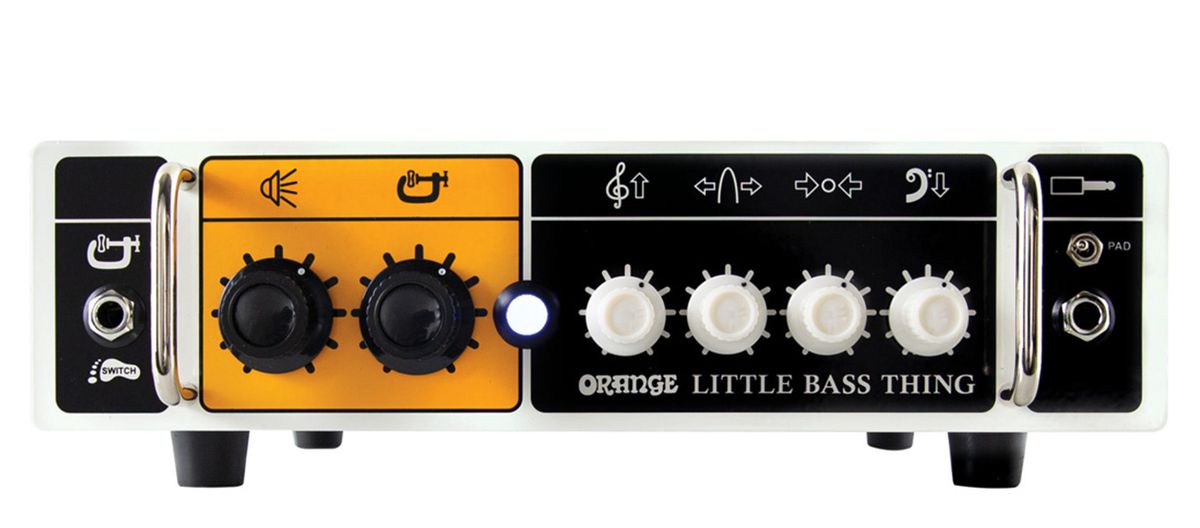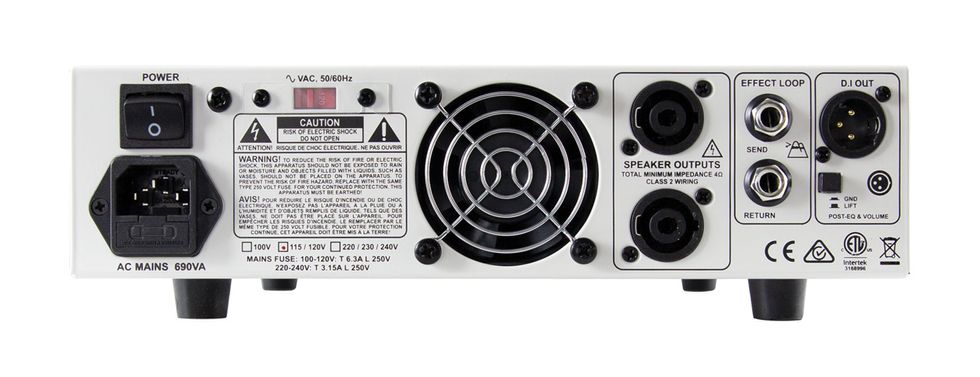
With 500 powerful watts and an exceptional optical compression circuit, there’s nothing little about this Thing's tone.
Recorded using an Mbox and running Logic X.
Clip 1: Yamaha BB3000S - slap with light compression - treble at 1 o’clock, mids at 10 o’clock, and bass at 1 o’clock.
Clip 2: Yamaha BB3000S - old-school with heavy compression - treble at 11 o’clock, mids at 12 o’clock, and bass at 2 o’clock.
Clip 3: Spector Euro4 LX - modern pick-style with mid scoop - treble at 11 o’clock, mids at 9 o’clock, and bass at 2 o’clock.
RatingsPros:Industry-leading onboard compression. Great parametric mid control. Tonal flexibility. Cons: Front control locations. No character/contour one-stop EQ control. No pre/post or level options for the onboard DI. Street: $699 Orange Little Bass Thing orangeamps.com | Tones: Ease of Use: Build/Design: Value: |
The brand Orange is as quintessentially British as, say, Mini Cooper cars or Triumph motorcycles. Even during the few years when Gibson owned the rights to the name, Orange continued manufacturing in England. The brand has certainly come a long way from its humble small-shop roots in London, where it started in 1968. And while Orange holds iconic status in the guitar universe, many of us bassists, me included, have not been exposed to the brand as often as our guitar playing friends. A few years ago, however, the company made a noticeable push to boost their presence as a major player in the low-end world. More recently, Orange has released the class-D, 500-watt Little Bass Thing, which is quite a playful name from a brand known for some seriously mean, overdriven rock tones.
Using a Different Road Map
First off, it’s not orange. It’s mostly white! But my initial impression was that it’s a great-looking amplifier and has enough of the signature orange color to where there can be no mistake about its pedigree. The layout of the 6 1/2-pound amp’s front panel is quite unorthodox to those of us who are not frequent Orange users. The input jack is located on the far right, while the main volume control is on the far left, next to a second input jack for a footswitch (not included) to turn the onboard compression on and off.
The EQ section moves from right to left, starting with the bass control, which took me a little getting used to. The EQ also features parametric midrange, with one control setting the amount of boost/cut and the other selecting the frequency. As part of the company’s visual legacy, all the front controls are labeled with symbols rather than text. Another unorthodox visual touch is the main-power indicator light, which is located near the middle of the front section, between the EQ panel and the compressor/master volume panel. The only other feature on the sparse frontside is a -6 dB input-level pad switch for active basses, located next to the input jack.
The back of the class-D amp is also quite minimalist, with a DI out, an effects loop, two speaker outputs, the main power switch, and a power-cable input. The most noteworthy feature on the rear panel is a switch between voltages for worldwide travel. This switch is smartly covered by a piece of plastic which is screwed into place for protection from the potentially catastrophic results of unintentional switching.
Smash That Tone Some More, Please!
I plugged in my trusty 36-year-old Yamaha BB3000S and played some old-school slap lines to get the basic feel of the amplifier. Within the first minute, I started closely examining the compressor, for a couple reasons. First, I’m just very skeptical about onboard compressors in general, and second, when turning up the compressor dial on the Little Bass Thing, the amp’s volume increased pretty dramatically.
That said, my jaw dropped upon hearing the tone, because the Little Bass Thing’s onboard compressor literally produces a sound on par with some of the best studio compressors I have heard. It actually feels the same. What I mean by that is that it grabs the note, evens out the attack, makes the sustain improve, and, most important, adds warmth without necessarily adding low end. This was by far most noticeable in the upper register, where the onboard compressor quickly added body to melodies and rounded off pops beautifully when slapping, without sacrificing the directness of the attack.

Curious as I am, I contacted Orange to get some more information about this particular compressor. I learned that the circuit in the Little Bass Thing is a simplified version of the same circuit found in the company’s Kongpressor pedal, an optical, class-A compressor. Once I turned my ear to listening to the rest of the sound, I was presented with a clean, punchy slap tone that did not get overbearing in the highs. The Little Bass Thing does not sound “vintage” by any means, but it stakes a tasteful claim to the land slightly less bright than many modern, more hi-fi amps.
With the same bass, I engaged the compressor to a much more drastic setting, dialed back the tone control on the bass, and cut some high mids on the amplifier. The result was a slightly less-dark version of a Motown sound, with the extra compression adding a drive and intensity that I enjoyed. It is worth noting that the Little Bass Thing does not have a control to actually add overdrive from the preamp, like many other models, but the simple volume control really helps set the Little Bass Thing apart from the pack.
Later, I grabbed a Spector Euro4 LX and played with a pick. It was simple finding the frequency that needed cutting in the mids with the frequency selection control. I added some lows on the amp as well, to give the modern, focused, active Spector a looser and more vintage feel. I found that the Little Bass Thing overall delivers a tone slightly firmer in the low mids than many other amps from traditionally rock-leaning manufacturers. This became especially usable when recording.
The Verdict
The Orange Little Bass Thing doesn’t sound like other amplifiers I’ve reviewed, mainly because it doesn’t try to be completely clean and transparent, nor does it place a very strong fingerprint/character on the tone. This amplifier lands in the middle, where it adds just enough personality to know your bass has gone through an amp. This will make the Little Bass Thing applicable to so many more styles than just traditional, groovy, British-style fuzz-rock. Yeah, baby!
